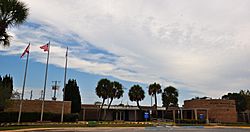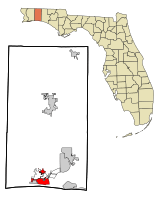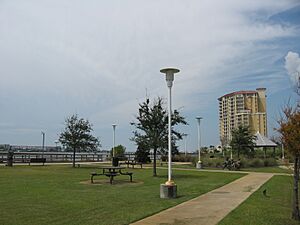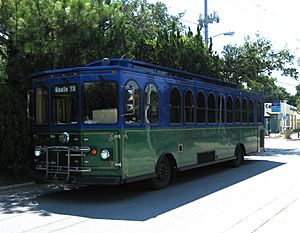Fort Walton Beach, Florida facts for kids
Quick facts for kids
Fort Walton Beach, Florida
|
||
|---|---|---|
| City of Fort Walton Beach | ||

Fort Walton Beach City Hall, September 2014
|
||
|
||
| Nicknames:
"The Emerald Coast", "The Camellia City", "The Sonic City"
|
||
| Motto(s):
"A City On The Move!"
|
||

Location in Okaloosa County and the state of Florida
|
||
| Country | ||
| State | ||
| County | ||
| Incorporated (city) | 1941 | |
| Area | ||
| • Total | 7.72 sq mi (20.00 km2) | |
| • Land | 7.64 sq mi (19.79 km2) | |
| • Water | 0.08 sq mi (0.20 km2) | |
| Elevation | 7 ft (2 m) | |
| Population
(2020)
|
||
| • Total | 20,922 | |
| • Density | 2,737.41/sq mi (1,056.99/km2) | |
| Time zone | UTC−6 (CST) | |
| • Summer (DST) | UTC−5 (CDT) | |
| ZIP Codes |
32547-32549
|
|
| Area code(s) | 850 | |
| FIPS code | 12-24475 | |
| GNIS feature ID | 0282710 | |
| Website | http://www.fwb.org | |
Fort Walton Beach, often called FWB, is a city in southern Okaloosa County, Florida, United States. In 2020, about 20,922 people lived there. This was an increase from 19,507 people in 2010. It is a main city in the larger area that includes Crestview and Destin.
Fort Walton Beach is a popular place for fishing and beach vacations all year. The busiest time is summer. Many visitors come then, which helps the local economy a lot.
Contents
History of Fort Walton Beach
Ancient People and Early Explorers
Long ago, from about 1100 to 1550 CE, a group of people called the "Fort Walton Culture" lived here. They built large mounds of earth. These people were very skilled. They farmed, made different kinds of pottery, and had organized villages.
The first Europeans to visit this area were part of Álvar Núñez Cabeza de Vaca's group in 1528. They traveled by boat along the coast. They described the area as having "poor and wretched people" who fished.
An old Spanish map from 1566 called the area "40 deaths a day." Later, English and French maps named it "Baya Santa Rosa" or "Bay St. Rose." You can see some Spanish items, like a piece of leather armor, at the Indian Temple Mound Museum.
No Pirates Here!
Many people think pirates used this area as a secret hideout. But there is no proof of this in old records. Pirates were common in the Gulf of Mexico. They came from places like Hispaniola and the Florida Keys. They attacked Spanish forts and other places. One famous adventurer, William Augustus Bowles, was based nearby. But he was not called "Billy Bowlegs" in his time.
First Settlers and Camp Walton
During the time when Spain and England were exploring, the Fort Walton Beach area was mentioned in some journals. But no one built a lasting settlement there yet.
The first permanent settlers came from Walton County, Florida. The area was first called "Anderson." John Anderson and Andrew A. Alvarez were among the first to get land here in 1838. The name "Anderson" was on maps until 1884. The name "Camp Walton" first appeared on Florida maps in 1911.
In 1861, Camp Walton was a camp for the Confederate Army. It was a fortified post with soldiers called the "Walton Guards." Their job was to protect the "Narrows" from Union ships. The soldiers at Camp Walton also dug up ancient Native American remains from the Indian Temple Mound. They displayed these at their camp. The camp was closed in August 1862.
Becoming Fort Walton Beach
On April 11, 1879, John Thomas Brooks bought 111 acres of land. This land became what is now downtown Fort Walton Beach. The United States Post Office changed the name from Camp Walton to Fort Walton on March 1, 1932.
In 1940, Fort Walton had 90 residents. It officially became a city on June 16, 1941.
The city's name changed again to Fort Walton Beach on June 15, 1953. This change also included a part of Santa Rosa Island, which was called Tower Beach. Tower Beach used to be an amusement area with a boardwalk and cottages. A fire destroyed much of it in 1942. This part of Santa Rosa Island is now known as Okaloosa Island.
By 1956, Fort Walton Beach had 9,456 residents. By 1960, this number grew to 11,249.
Geography and Climate
Where is Fort Walton Beach?
Fort Walton Beach is located at 30°25′13″N 86°37′00″W / 30.420199°N 86.616727°W. The city covers about 21.3 square kilometers (8.2 square miles). Most of this area is land, and a small part is water.
Weather in Fort Walton Beach
Fort Walton Beach has hot and very humid summers. These usually last from late May to mid-September. Autumns are generally warm, from mid-September to early December. Winters are short and mild, from mid-December to late February. Springs are warm, from late February to late May.
The city gets about 55.35 inches of rain each year. Summer is the wettest season. Snow and freezing rain are very rare here. Snow falls about once every 10 to 15 years. The last time it snowed a measurable amount was in 1977.
| Climate data for Fort Walton Beach, Florida (Destin–Fort Walton Beach Airport), 1991–2020 normals, extremes 1996–present | |||||||||||||
|---|---|---|---|---|---|---|---|---|---|---|---|---|---|
| Month | Jan | Feb | Mar | Apr | May | Jun | Jul | Aug | Sep | Oct | Nov | Dec | Year |
| Record high °F (°C) | 89 (32) |
81 (27) |
86 (30) |
89 (32) |
98 (37) |
102 (39) |
99 (37) |
100 (38) |
100 (38) |
93 (34) |
91 (33) |
85 (29) |
102 (39) |
| Mean maximum °F (°C) | 74.1 (23.4) |
74.3 (23.5) |
79.6 (26.4) |
83.3 (28.5) |
91.1 (32.8) |
94.5 (34.7) |
95.2 (35.1) |
95.2 (35.1) |
93.5 (34.2) |
88.7 (31.5) |
81.1 (27.3) |
77.2 (25.1) |
97.3 (36.3) |
| Mean daily maximum °F (°C) | 63.1 (17.3) |
65.8 (18.8) |
70.7 (21.5) |
76.2 (24.6) |
83.5 (28.6) |
88.9 (31.6) |
90.9 (32.7) |
90.6 (32.6) |
88.5 (31.4) |
80.9 (27.2) |
72.1 (22.3) |
65.6 (18.7) |
78.1 (25.6) |
| Daily mean °F (°C) | 54.2 (12.3) |
56.9 (13.8) |
62.2 (16.8) |
68.1 (20.1) |
75.8 (24.3) |
81.5 (27.5) |
83.6 (28.7) |
83.2 (28.4) |
80.5 (26.9) |
72.1 (22.3) |
62.6 (17.0) |
56.6 (13.7) |
69.8 (21.0) |
| Mean daily minimum °F (°C) | 45.3 (7.4) |
47.9 (8.8) |
53.6 (12.0) |
60.1 (15.6) |
68.0 (20.0) |
74.1 (23.4) |
76.2 (24.6) |
75.8 (24.3) |
72.4 (22.4) |
63.2 (17.3) |
53.0 (11.7) |
47.5 (8.6) |
61.4 (16.3) |
| Mean minimum °F (°C) | 28.6 (−1.9) |
33.2 (0.7) |
38.8 (3.8) |
49.5 (9.7) |
57.9 (14.4) |
69.3 (20.7) |
72.2 (22.3) |
72.5 (22.5) |
64.5 (18.1) |
49.0 (9.4) |
38.7 (3.7) |
35.0 (1.7) |
27.1 (−2.7) |
| Record low °F (°C) | 20 (−7) |
23 (−5) |
30 (−1) |
41 (5) |
49 (9) |
62 (17) |
66 (19) |
66 (19) |
55 (13) |
42 (6) |
30 (−1) |
22 (−6) |
20 (−7) |
| Average precipitation inches (mm) | 4.52 (115) |
4.96 (126) |
4.70 (119) |
4.55 (116) |
3.22 (82) |
4.70 (119) |
5.77 (147) |
6.08 (154) |
5.18 (132) |
2.82 (72) |
4.13 (105) |
4.72 (120) |
55.35 (1,406) |
| Average precipitation days (≥ 0.01 in) | 10.0 | 9.4 | 8.7 | 7.9 | 6.4 | 9.7 | 11.2 | 12.4 | 8.2 | 6.1 | 8.9 | 10.6 | 109.5 |
| Source: NOAA (mean maxima and minima 2006–2020 | |||||||||||||
Getting Around Fort Walton Beach
Airports and Public Transport
The nearest airport is Destin-Fort Walton Beach Airport (VPS). It serves Fort Walton Beach and Valparaiso. Several airlines fly from here to cities like Atlanta, Dallas, and Houston.
Okaloosa County Transit offers public transportation. You can ride trolleys and buses throughout Fort Walton Beach and Okaloosa County. The main stop is Uptown Station.
Main Roads
- State Road 189 goes north and south through downtown Fort Walton Beach.
- State Road 85 also goes north and south. It leads to Crestview, the county seat.
- US 98 is a major east-west road. It runs through downtown Fort Walton Beach. The Brooks Bridge on US 98 connects downtown to Okaloosa Island. US 98 goes east to Destin and west to Pensacola.
People of Fort Walton Beach
| Historical population | |||
|---|---|---|---|
| Census | Pop. | %± | |
| 1950 | 2,463 | — | |
| 1960 | 12,147 | 393.2% | |
| 1970 | 19,994 | 64.6% | |
| 1980 | 20,829 | 4.2% | |
| 1990 | 21,471 | 3.1% | |
| 2000 | 19,973 | −7.0% | |
| 2010 | 19,507 | −2.3% | |
| 2020 | 20,922 | 7.3% | |
| U.S. Decennial Census | |||
In 2020, there were 20,922 people living in Fort Walton Beach. There were 9,246 households and 5,195 families.
Population Makeup
The table below shows the different groups of people living in Fort Walton Beach.
| Race | Pop 2010 | Pop 2020 | % 2010 | % 2020 |
|---|---|---|---|---|
| White (NH) | 14,245 | 13,777 | 73.03% | 65.85% |
| Black or African American (NH) | 2,331 | 2,284 | 11.95% | 10.92% |
| Native American or Alaska Native (NH) | 104 | 65 | 0.53% | 0.31% |
| Asian (NH) | 618 | 828 | 3.17% | 3.96% |
| Pacific Islander or Native Hawaiian (NH) | 54 | 20 | 0.28% | 0.10% |
| Some other race (NH) | 31 | 122 | 0.16% | 0.58% |
| Two or more races/Multiracial (NH) | 586 | 1,382 | 3.00% | 6.61% |
| Hispanic or Latino (any race) | 1,538 | 2,444 | 7.88% | 11.68% |
| Total | 19,507 | 20,922 |
Famous People from Fort Walton Beach
Many interesting people have connections to Fort Walton Beach:
- Aric Almirola - A NASCAR race car driver.
- Richard Covey - An astronaut.
- Bud Day - A retired U.S. Air Force colonel and Vietnam War prisoner of war. He received the Medal of Honor.
- Jason Elam - An NFL kicker who won two Super Bowls with the Denver Broncos.
- Scott Fletcher - A MLB baseball player.
- Matt Gaetz - An American politician.
- Shane Gibson - A famous heavy metal guitarist for the band Korn.
- Edward L. Hubbard - A retired Air Force officer, author, and artist. He was also a Vietnam Prisoner of War.
- Rick Malambri - An actor.
- Brian Marshall - The bass player for the rock bands Creed and Alter Bridge.
- Matt Moore - A pitcher for the Texas Rangers baseball team.
- Carolyn Murphy - A famous model.
- Danny Wuerffel - A Heisman Trophy winner for the University of Florida and a quarterback for the New Orleans Saints.
Economy of Fort Walton Beach
The economy of Fort Walton Beach mainly depends on two things: tourism and the military.
Military Bases
There are two large Air Force bases near Fort Walton Beach:
- Hurlburt Field is home to the Air Force Special Operations Command (AFSOC).
- Eglin AFB is one of the largest Air Force bases in the world. It covers 724 square miles! It is used for testing missiles and bombs. For example, the "Mother of All Bombs" (MOAB) was first tested here in 2003.
Many businesses in the area support these bases. This includes companies that work for the military and service industries.
Tourism
Tourism is a big part of the economy, especially in the summer. Many "snowbirds" (people who come from colder places for the winter) also visit. The city holds an annual event called the Billy Bowlegs Pirate Festival in June.
Top Employers
Here are some of the biggest employers in Fort Walton Beach:
| # | Employer | Employees |
|---|---|---|
| 1 | Eglin Air Force Base | 16,476 |
| 2 | Hurlburt Field | 11,171 |
| 3 | Okaloosa County School District | 3,278 |
| 4 | Okaloosa County | 1,383 |
| 5 | Fort Walton Beach Medical Center | 1,305 |
| 6 | DRS Technologies | 875 |
| 7 | InDyne | 786 |
| 8 | Northwest Florida State College | 763 |
| 9 | ResortQuest | 750 |
| 10 | BAE Systems | 700 |
Sister Cities
Fort Walton Beach has a special connection with:
 Quezon City, Philippines (since October 1977)
Quezon City, Philippines (since October 1977)
See also
 In Spanish: Fort Walton Beach para niños
In Spanish: Fort Walton Beach para niños




